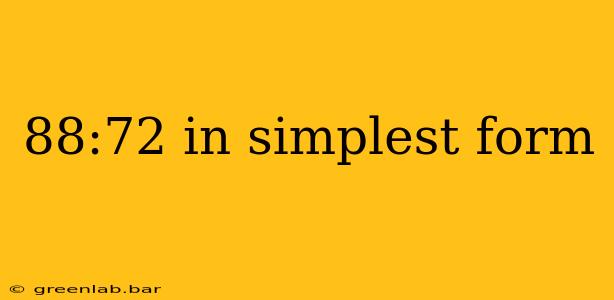Simplifying Fractions: A Step-by-Step Guide to Reducing 88/72
The fraction 88/72 might look daunting at first, but simplifying it is a straightforward process involving finding the greatest common divisor (GCD) of the numerator (88) and the denominator (72). This guide will walk you through the steps, explaining the concepts along the way.
Understanding Greatest Common Divisor (GCD)
The GCD is the largest number that divides evenly into both the numerator and the denominator without leaving a remainder. Finding the GCD is key to simplifying fractions to their simplest form. There are several methods to find the GCD, including:
-
Listing Factors: Write down all the factors of both numbers and identify the largest one they share. While this works well for smaller numbers, it can become cumbersome with larger ones.
-
Prime Factorization: Break down both numbers into their prime factors (numbers divisible only by 1 and themselves). The GCD is the product of the common prime factors raised to the lowest power.
-
Euclidean Algorithm: This is a more efficient method for larger numbers, involving repeated division until the remainder is zero.
Simplifying 88/72 using Prime Factorization
Let's use prime factorization to find the GCD of 88 and 72:
Prime factorization of 88:
88 = 2 x 44 = 2 x 2 x 22 = 2 x 2 x 2 x 11 = 2³ x 11
Prime factorization of 72:
72 = 2 x 36 = 2 x 2 x 18 = 2 x 2 x 2 x 9 = 2 x 2 x 2 x 3 x 3 = 2³ x 3²
Identifying the GCD:
Comparing the prime factorizations, we see that both 88 and 72 share three factors of 2 (2³). Therefore, the GCD of 88 and 72 is 8.
Reducing the Fraction
Now that we've found the GCD (8), we can simplify the fraction by dividing both the numerator and the denominator by 8:
88 ÷ 8 = 11
72 ÷ 8 = 9
Therefore, 88/72 simplified to its lowest terms is 11/9.
Conclusion
Simplifying fractions is a fundamental skill in mathematics. Understanding the concept of the greatest common divisor and employing methods like prime factorization allows for efficient and accurate simplification. Remember, always divide both the numerator and the denominator by the GCD to arrive at the simplest form of the fraction.

